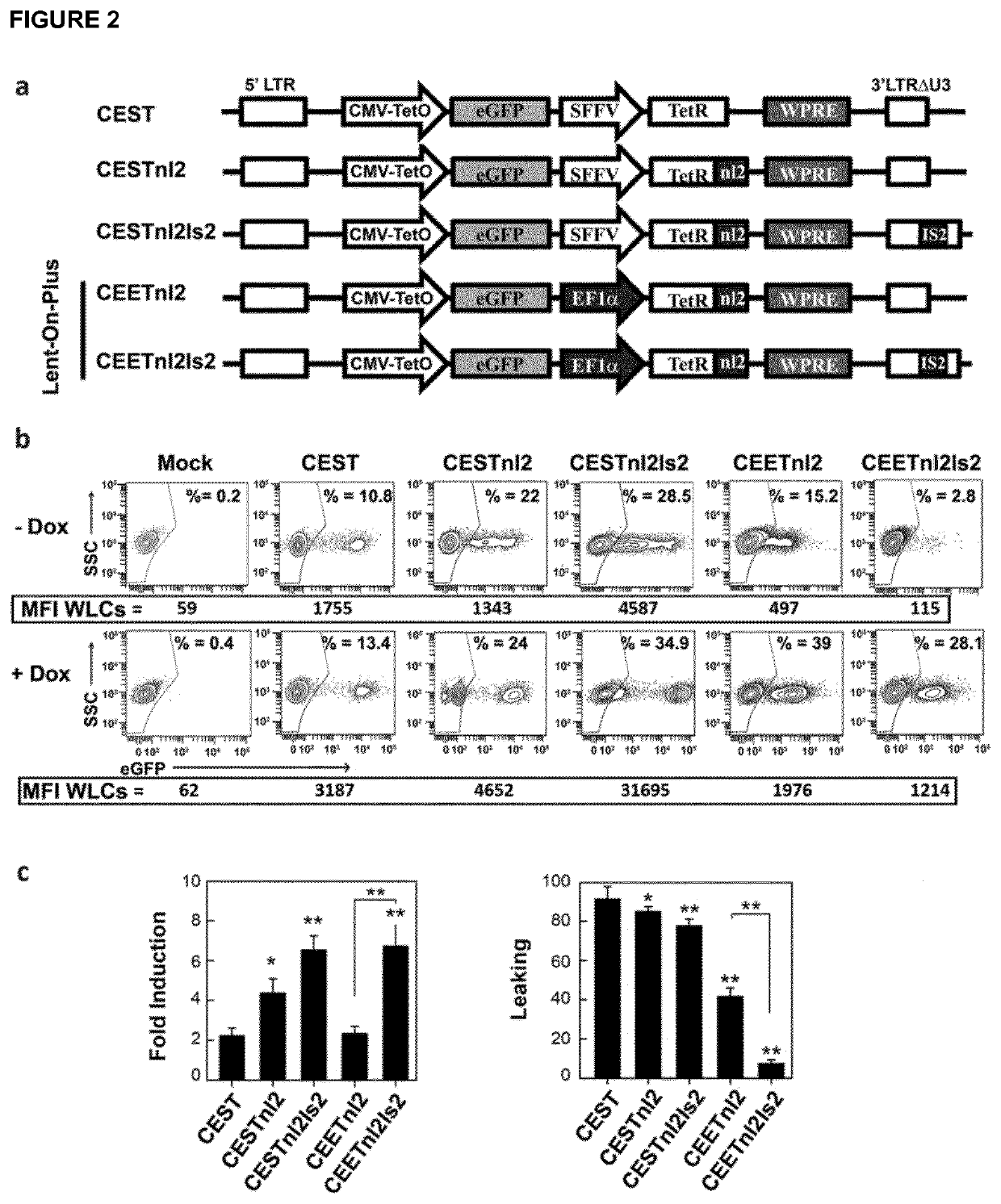Lent-on-plus system for conditional expression in human stem cells
a conditional expression and human stem cell technology, applied in the field of improved gene transfer vectors, can solve the problems of loss of expression capacity, insufficient strategies alone to solve the obstacles, and difficult control of transgene expression, etc., to improve the fold induction of egfp, improve the expression of egfp, and reduce the unspecific expression of egfp
- Summary
- Abstract
- Description
- Claims
- Application Information
AI Technical Summary
Benefits of technology
Problems solved by technology
Method used
Image
Examples
example 1
nt of an All-In-One LVs System with Lower Leaking and Enhanced Inducibility: The Lent-On-Plus System
[0107]In order to generate Tet-On all-in-one LVs that tightly regulate transgene expression in human stem cells we have constructed several LVs harboring different modifications (FIG. 2a). All the constructs express eGFP through the CMV-TetO promoter but have different backbones configurations to increase TetR levels in the nuclei, to avoid promoter silencing and to shield the LVs from enhancers present nearby the integration sites. The original TetR proteins translocate poorly to the nucleus (Ogueta S. B. et al., Design and in vitro characterization of a single regulatory module for efficient control of gene expression in both plasmid DNA and a self-inactivating lentiviral vector. Mol Med (2001)), a crucial step to achieve transcriptional repression. We initially tested two different nuclear localization signals and selected the TetRnl2 as the best repressor to be used in our LV syst...
example 2
Lent-On-Plus LVs Efficiently Regulate Transgene Expression in Human Mesenchymal Stromal Cells
[0116]We next tested the new inducible systems in hMSCs. We transduce hMSCs with the CESTnl2, CESTnl2Is2, CEETnl2 and CEETnl2Is2 LVs at a MOI=1 and 10 days later analyzed for GFP expression in the presence or absence of Dox (FIG. 5a). As observed in 293T cells, the expression of the TetRnl2 through the hEF1α promoter (Lent-On-Plus LVs) reduced the leaking of the LVs (FIG. 5a right top plots) even at low vcn / c. Importantly, the combination of the hEF1α promoter and the Is2 insulator blocked the expression of eGFP almost completely in the absence of Dox (FIG. 5a, compare untransduced (top-left plot) with CEETnl2Is2-transduced (top-right plot) hMSCs). On the contrary, the vectors expressing TetRnl2 through the SFFV promoter (CESTnl2 and CESTnl2Is2) had high leaking at low vcn / c (FIG. 5a, top-left plots). Interestingly, the CEETnl2 LVs express even lower TetR levels than CESTnl2 LVs in MSCs (FIG...
example 3
n of Doxycycline-Responsive Pluripotent Stem Cells by the CEETnl2 and the CEETnl2Is2
[0119]The generation of pluripotent stem cells expressing the desired transgene under the tight control of an inducer has been a very difficult task to achieve due to the low efficiency of existing delivery methods, the strong silencing of the transgenes and the side effects of the transactivators. We hypothesized that the use of insulated LVs expressing the TetRnl2 through stable promoters could overcome previous existing limitations to generate Dox-inducible hESCs. To investigate this possibility, we first tested the Dox-responsiveness of two hESCs lines (AND-1 and H9) transduced with the CESTnl2, CESTnl2Is2, CEETnl2 and CEETnl2Is2 LVs at MOI=5 (FIG. 10). Neither, the CESTnl2 nor CESTnl2Is2 LVs could regulate transgene expression in hESCs (FIG. 10a, left plots). On the contrary, both Lent-On-Plus LVs expressing TetRnl2 through the hEF1α promoter (CEETnl2 and CEETnl2Is2) achieved low leaking (FIG. 1...
PUM
| Property | Measurement | Unit |
|---|---|---|
| temperature | aaaaa | aaaaa |
| density | aaaaa | aaaaa |
| time | aaaaa | aaaaa |
Abstract
Description
Claims
Application Information
 Login to View More
Login to View More - R&D
- Intellectual Property
- Life Sciences
- Materials
- Tech Scout
- Unparalleled Data Quality
- Higher Quality Content
- 60% Fewer Hallucinations
Browse by: Latest US Patents, China's latest patents, Technical Efficacy Thesaurus, Application Domain, Technology Topic, Popular Technical Reports.
© 2025 PatSnap. All rights reserved.Legal|Privacy policy|Modern Slavery Act Transparency Statement|Sitemap|About US| Contact US: help@patsnap.com



